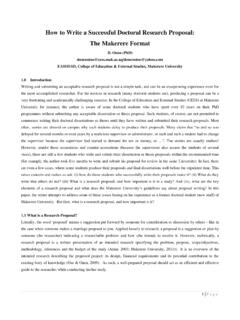Transcription of PROJECT PROPOSAL - COMMUNITY HEALTH – …
1 PROJECT PROPOSAL COMMUNITY HEALTH DEVELOPMENT AND IMPLEMENTATION OF LOCAL PUBLIC HEALTH STRATEGIES Contact: Vesna Bjegovic, MD, MSc, PhD Belgrade University School of Medicine, Institute of Social Medicine Dr. Subotica 15 11000 Belgrade, Serbia and Montenegro Tel: +381 11 643 830 Fax: +381 11 659 533 Email: Belgrade 2003 PROJECT PROPOSAL : COMMUNITY HEALTH Development and Implementation of Local Public HEALTH Strategies 1 Background During the last ten years the HEALTH infrastructure both for curative and preventive services has been gradually deteriorated in Serbia. Prevention of diseases, though historically considered as the flagship of the national HEALTH system, remains today far behind the curative medicine in terms of resource allocations to HEALTH care.
2 The network of the Institutes of Public HEALTH (IPH) is the main actor in public HEALTH development in the country. Today, however the network, which was supposed to be the pillar of a modern HEALTH , care system, is in the situation where the roles and tasks of its IPH remain unclear (Scheme 1). Scheme 1 Organizational structure of Public HEALTH in SerbiaPolicy and financeInstitutes of Public HealthNovi Sad, Ni , Kragujevac, Partners in communityNGOS choolsElderly HealthCare CentresGeneral practicionerPolivalent patronageNational expert group forPublic HealthRepublicGovernmentHealth InsuranceFundNational HealthCouncilMinistry serviceRegional Institutes of Public HealthInstitutes for HEALTH protection of studentsRepublic Institute of Public HEALTH Public HEALTH is the science and art of preventing disease.
3 Prolonging life and promoting mental and physical HEALTH and efficiency through organized COMMUNITY efforts. Public HEALTH may be considered as the structures and processes by which the HEALTH of populations is understood, safeguarded and promoted through the organized efforts of society . Population of Serbia experienced many social and economic threats during 1990s. Years of life under severe stress and trauma-ridden environment have brought depression and hopelessness, followed by general negligence towards HEALTH and increased risk behavior. During the last decade of the 20th century, the HEALTH status of the population of Serbia was harmfully influenced by numerous factors, but especially by the general situation in the country (the long lasting economic PROJECT PROPOSAL : COMMUNITY HEALTH Development and Implementation of Local Public HEALTH Strategies 2crisis, the consequences of war in the surrounding countries and in Serbia as well, wide range of economic and diplomatic sanctions).
4 The total population of Serbia, including Central Serbia and Vojvodina, is to be 7 875 380 according to Census 2002 (Federal Statistical Office 2002). The population of Central Serbia declined by more than 25 000 over decade, while the population of Vojvodina increased for more than 77 000. Serbia entered the crisis of the 1990s with the population profile overall of a developed country. The economic crisis led to a smaller number of births, increased emigration of young people and increased immigration of the elderly (among refugees and internally displaced persons).
5 Today the major trend is a rapid ageing of the population. Consequently, the population of Serbia can be classified among very old populations. According to the data from 2000, somewhat over 12% of residents are aged 65 years or more. The life expectancy at birth for males born in 1997/98 is in Vojvodina and in Central Serbia, while for females is higher: and respectively. National death registries for Serbia show that mortality among infants and children under five years declined by about half during 1990s. Infant mortality, which is a good indicator of general HEALTH status of the population, is decreasing over the recent years (from Central Serbia and - Vojvodina in 1990 to and respectively in 2000).
6 Mortality rate of children under 5 years in the Republic of Serbia during the last decade has also significantly decreased. Maternal deaths per 100 000 live births are relatively rare events; their number thus randomly varies year by year in Serbia. Nevertheless, the maternal mortality did not change significantly during the last 10 years and in 1999 it was per 100 000 live births. A three-year moving average also shows that the maternal mortality rate was low and essentially stable throughout the 1990s. However, mortality has risen among most adult age groups, during most years, since 1995. The rise was small among those under 65 years and therefore increased with age.
7 The chronic non-communicable diseases are dominating within the structure of death causes. At the first place are cardiovascular diseases with the share of in Central Serbia and in Vojvodina, followed by malignant neoplasm with the share of and respectively. According to the data of the mortality statistics (death certificates), there were no significant changes in the structure of causes of death during the last ten years. The survey of the HEALTH status, HEALTH needs and the utilization of HEALTH services of the population of Serbia conducted during the year 2000 by the Institute of Public HEALTH , showed that even of the adult population are smokers and that the one-third of all women and nearly the half of men are daily smokers (Institute of Public HEALTH of Serbia 2000).
8 Smoking is the highest among those 19 34 years of age. The nutrition of the population is mostly improper, 37% of the population can be classified as moderate, while 17% of the population is over-weight. As much as 63% of individuals are spending their spare time sedentary. Of those individuals with sedentary type job, three quarters are spending their spare time likewise. Hypertension is diagnosed in 41% of adult population of Serbia, while 27% is anemic. Although alcohol is consumed regularly only by of the population, according to the weekly alcohol consumption, expressed by alcohol units and the estimated HEALTH risk, PROJECT PROPOSAL : COMMUNITY HEALTH Development and Implementation of Local Public HEALTH Strategies of adult population of Serbia are at lower risk, at high risk, and at the highest risk.
9 Females are most common in the lower risk category, and males in the high and highest risk category. Approximately of adults are taking different kinds of psychoactive drugs (diazepam, valium, amphetamines), while intake marijuana. Risky sexual behavior (not using condoms) exists in of the population. The survey showed that approximately 18% of the population of Serbia has some sort of physical impairment, which in more than half of them is causing certain difficulties. Nowadays many HEALTH problems in Serbia (FR Yugoslavia) can be classified as public HEALTH problems.
10 The challenge for public HEALTH is to cope with conflicting priorities for improving the HEALTH status of the population, as well as to reform public HEALTH and the HEALTH care system. Therefore, public HEALTH and other professionals need a broad range of skills and selective depth in specialist knowledge areas of New Public HEALTH (NPH). However, specialist knowledge is locked up within different disciplines that communicate among themselves rather rarely (Epidemiology, Hygiene, Social Medicine, Occupational Medicine etc.). The whole public HEALTH is medically driven with little input from other professions.



